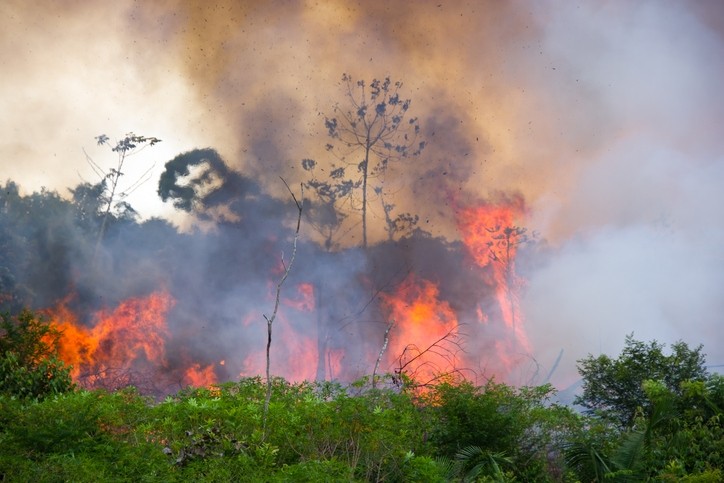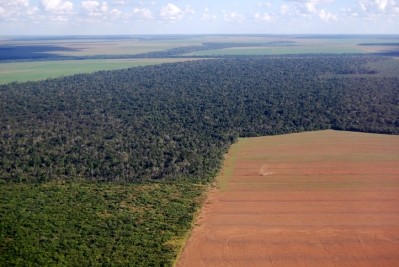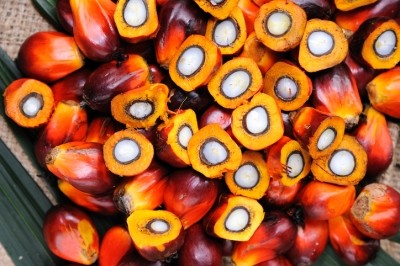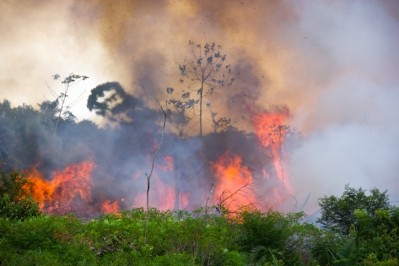Brazilian trade group refutes claims soy linked to fires in the Amazon rainforest

It said the soybean plantings in the ten areas of the Amazon region where fires have been report is minimal, and immaterial to Brazil’s overall soy production.
Abiove sent FeedNavigator a graph outlining the data. A spokesperson for the organization told us its compiled data on soy plantings was based on a recent study from the Amazon Environmental Research Institute (IPAM).
“Abiove's chart crosses IPAM data on fire outbreaks with information on the area of each listed municipality and the area of soybeans currently planted.”
The trade group said the 10 municipalities most affected by the forest fires between January and July this year recorded soy plantings on only 30,000 hectares in the 2018/2019 season.
Brazil’s total planted soy area is 36 million hectares.
Abiove said it was motivated to gather the data to contest allegations that soy was contributing to the fires and deforestation in those areas.
The Abiove chart shows that some 17,000 hectares were planted with soy this year around Novo Progresso in the state of Pará. A recent article on Reuters noted that Novo Progresso "was the epicenter of the alleged 'Fire Day' earlier this month which reportedly called on people to set fires to clear land for agriculture and cattle grazing - a claim prosecutors are still investigating."

'Deforestation is fanning the flames'
The outbreak of record numbers of fires can be attributed to deforestation and not drought, according to a technical memo on the current burning season that IPAM released late August.
“Between January 1 and August 14 of this year, the National Institute for Space Research (INPE) identified 32,728 outbreaks in the Amazon region. One factor that could potentially explain this marked increase would be an intense drought as recorded in 2016. However, this hypothesis must be rejected: despite being the dry season, moisture levels in the Amazon are currently above average compared to the last three years.
“If the dry season does not explain the current fires, the only other plausible explanation is that deforestation is fanning the flames. Fire is commonly used to clear the terrain after forests are felled. An analysis of current hotspots and the logging record produced by the Deforestation Alert System (SAD) suggests that this is indeed the case,” found the IPAM report.
Maps linking companies to fires
New maps and analysis from Washington DC based campaigners, Mighty Earth, based on data from NASA, CONAB, and Imazon, claim to show which companies are most closely linked to the burning based on the location of slaughterhouses and soy silos around those fires. The report can be accessed here.
Mighty Earth said one of the key regions where burning took place was Altamira. The environmental campaigners claimed that, according to Trase, Cargill purchases soy from Altamira and Cargill’s port in nearby Santarem is clearly the most likely place for export for all soy from that area.
Cargill referred us on to Abiove when we sought comment on the above allegation.
The spokesperson added: "To prevent non-compliant supply, Cargill has clear protocols in place which require cross checks against the Brazilian list of embargoed farms. We conduct this check both before a contract is established and again before physical product is received. If cases of illegal activity are confirmed, we’ll take appropriate action in line with our policy.”
Mighty Earth CEO, Glenn Hurowitz, when being interviewed by this publication last week, claimed that there is a sense of impunity in both Brazil and Bolivia about deforestation and burning that spurred this wave of fires, with less responsible producers picking up on clear signals from both the Brazilian and Bolivian governments.
“Both Jair Bolsonaro, [Brazil’s president], and Evo Morales, [Bolivia’s president], have encouraged the burning of forests to grab land and expand agricultural production. And Brazil’s environmental enforcement authorities are giving advanced notice about inspections, so producers feel they can get away with deforestation," he stressed.
'European feed companies do not source from the Amazon Biome'
Last week, president of EU feed manufacturer representative, FEFAC, Nick Major, said it would be wrong to point to European use of soybean meal as a driver of the fires in the Amazon. Soy grown on deforested land from the Amazon Biome as an origin is excluded due to the Amazon Soy Moratorium (ASM), he said.
"FEFAC supported the development of the ASM in 2006, which is still in effect. European feed companies, therefore, do not source from the Amazon Biome. In addition, EU soy imports from South America have drastically declined over the past year and half, to the benefit of soy imports from the US.
"In 2015, FEFAC also developed its Soy Sourcing Guidelines, which help to ensure the exclusion of illegal deforestation. As of August 2019, over 160 European feed companies have voluntary committed to sourcing soy for feed purposes according to the Soy Sourcing Guidelines by 2025,” added Major.










